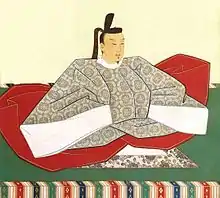Eikyō
Eikyō (永享) was a Japanese era name (年号,, nengō,, lit. "year" name) after Shocho and before Kakitsu. This period started in September 1429 and ended in February 1441.[1] During this time, the emperor was Go-Hanazono-tennō (後花園天皇).[2]
Events of the Eikyō era

In the 5th year of Eikyō, Emperor Go-Komatsu died
- 14 April 1429 (Eikyō 1, 9th day of the 3rd month): The name of Ashikaga Yoshinobu was changed to Yoshinori.[3]
- 1429: Yoshinori appointed shogun.[4]
- 1433 (Eikyō 5, 6th month): Letter from Emperor of China to the Shogun assumes wrongly that the head of the Ashikaga shogunate is the "king of Japan."[5]
- 1433 (Eikyō 5, 10th month): Former-Emperor Go-Komatsu died.[6]
- 1438 (Eikyō 10): Revolt against the shogunate led by Ashikaga no Mochiuji.[7]
Related pages
References
- Nussbaum, Louis-Frédéric. (2005). "Eikyō" in Japan Encyclopedia, p. 171.
- Nussbaum, "Go-Hanazono Tennō," p. 252; Titsingh, Isaac. (1834). Annales des empereurs du Japon, pp. 331-340.
- Titsingh, p. 333.
- Ackroyd, Joyce. (1982) Lessons from History: The Tokushi Yoron, p. 330.
- Titsingh, p. 335.
- Titsingh, p. 335; Imperial Household Agency (Kunaichō): 後小松天皇 (100)
- Nussbaum, "Eikyō no Ran" at p. 171.
Other websites
- National Diet Library, "The Japanese Calendar" -- historical overview plus illustrative images from library's collection
| Eikyō | 1st | 2nd | 3rd | 4th | 5th | 6th | 7th | 8th | 9th | 10th | 11th | 12th | 13th |
|---|---|---|---|---|---|---|---|---|---|---|---|---|---|
| 1429 | 1430 | 1431 | 1432 | 1433 | 1434 | 1435 | 1436 | 1437 | 1438 | 1439 | 1440 | 1441 |
| Preceded by: Shōchō |
Era or nengō: Eikyō |
Succeeded by: Kakitsu |
This article is issued from Wikipedia. The text is licensed under Creative Commons - Attribution - Sharealike. Additional terms may apply for the media files.